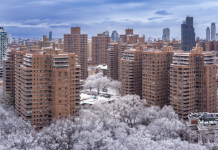
Is the Lower East Side ready to make a deal? That’s the question two urban planners hired by the city will be seeking to answer when they meet with members of Community Board 3’s SPURA Task Force Thursday night. It will be the third of four “facilitated” sessions meant to determine if neighborhood factions can finally reach a consensus on a development plan for the Seward Park Urban Renewal Area. Recently, I discussed the deliberations with CB3 Chairman Dominic Pisciotta, who played a central role in the creation of the panel. The time is right, he said, for action, “to do something good for the neighborhood.”
People on the Lower East Side have been fighting about SPURA since at least 1967, when thousands of homes and businesses were bulldozed in the name of urban renewal. Pisciotta first became interested in the issue in late 2003, not long after moving into the Seward Park Cooperative on Grand Street. During an infamous public hearing to discuss Michael Bloomberg’s mixed-use plan for SPURA, Pisciotta witnessed first hand the bitter divisions that have sabotaged every redevelopment effort in the past 43 years. “That was a really crazy night,” he said, “I was shocked by the comments from both sides.”
After joining the community board in 2005, Pisciotta knew he wanted to revisit the issue. Following CB3’s rezoning of 111 blocks of the Lower East Side in 2008, there was new optimism about the neighborhood’s ability to get things done. Elected chair, he felt the time was right to tackle Seward Park redevelopment. It was at this time that he began setting the stage for new talks:
“We definitely wanted to take the good things out of the rezoning process and I also wanted to do things a little bit differently than how things had been done. There were certainly some lessons that had been learned.”
CB3’s land use, zoning and housing committee was retooled to accommodate the SPURA deliberations:
“A lot of the people who were already on the committee, a lot of the public members, had an interest in what happens with SPURA. In a lot of ways that’s been a good thing because they have established relationships with each other, and I saw it as an opportunity to build off of that. But also, knowing that there are important stakeholders, especially from Grand Street, who were not on the committee, I needed to balance out the committee as best as I could.”

The committee’s membership has evolved since the process began. Today, there are 21 participants – who are often categorized based on their support or opposition to affordable housing on the SPURA parcels:
“I have really strived to make it even. There are probably more affordable housing people on there, but David (McWater, committee chairman) has held true to making everything more consensus driven than majority rules. I think the balance has worked… I think overall I was certainly looking to figure out skills, experience, well represented constituencies, thoughtfulness. I didn’t want anyone who was going to be so extreme. I wanted people to be able to work together. There is a lack of racial diversity, which I’m starting to address. But I want to make sure that, given where we are now, that anyone new that I introduce will add value to the discussion. Anyone new would have a lot of catching up to do. I’m really not looking to upset the established working relationships.”
In the last few months, some members have called for creating more opportunities for the community-at-large to weigh in on the Seward Park plan. McWater has indicated there will likely be town hall meetings if the committee makes progress this summer and fall. I asked Pisciotta what he thinks about the prospects for a town hall sometime in the near future:
“Honestly I think we need to see what happens during the next two meetings. I think John Shapiro (the urban planner working with the committee) laid it out pretty well in the last meeting that we need to decide whether the people on the committee are able to work together and are really willing to cede some ground. If not, we’re not going to get to the point of having a town hall meeting, which I think would be a real shame because I think we’ve made progress.”
Pisciotta said he was encouraged when the city’s Economic Development Corp., approached him last year, offering to become actively involved in the process. It was an expression of confidence, he said, that there might just be a new spirit of accommodation on the Lower East Side. But Pisciotta said the city’s patience is sure to wear thin if progress is not made relatively soon:
“It has drawn out the process. To me, it’s been a slow process. Some people, I think, are very comfortable with how slow it’s been. Other people want it to be even slower. But my feeling is that, this property has been vacant for over 40 years. We’ve had multiple battles where it’s been clear what the lines are, who’s willing to come to the middle and who’s not. I would hope we could use those experiences to really move forward and come up with a consensus relatively quickly. I think two years is a good amount of time for the different stakeholders to express themselves and have their input, for the public to come and speak at all the meetings. I really feel like all the meetings with the principals that we’ve had, on average, we have probably had 10 people from the public who have showed up and spoken.
Last month, Shapiro said the focus now is on the discussions taking place among committee members. Some residents who came to speak were frustrated that they had to wait until the end of the meeting to express their opinions. This is what Pisciotta had to say about that:
I would encourage people to be part of the process now. Even if they’re not able to have a dialogue during meetings I think it’s important for them to see and understand what’s being considered, what’s viable and what’s not. I don’t want to see people wait that long (until town hall meetings are held) to get involved… I’ll be disappointed if (organizations interested in SPURA) only show up at the 11th hour.
While Pisciotta is passionate about making headway on SPURA, he has few preconceived notions about what should be built. As a practical matter, he supports a mixed use development, including both affordable and market rate apartments, as well as commercial uses. Based on his own experience, he believes the SPURA project should make home ownership viable for a wide variety of people:
“I was very fortunate when I bought into the co-ops. I feel like I understand how hard it is to buy a home in New York City. So I certainly think it’s valuable to have affordable housing for low and moderate income people. I probably identify mostly with those middle income people. I probably make too much money to qualify for any sort of subsidies but not enough to pay my 30% down payment. But then I got a really great deal on my apartment. The co-ops were created for middle income people. Manhattan has lost a lot of its middle class, so potentially this area could recapture some of that and add to the economic diversity of the neighborhood.”
Pisciotta also said, “I think it would be amazing if there was a for-profit cultural institution, but something different. How about a really interesting children’s museum that’s family oriented? He added:
“What would be interesting would be a partnership between a big institution, such as a large and well known ‘for profit museum,’ and a smaller one from the community such as Clemente Soto Velez (non-profit) that could do something like this together. I haven’t spoken to any of these organizations… but a partnership like this would complement the ethnic diversity of the neighborhood and recognize its history as a multicultural arts center. It would really need to offer something unique, though, in terms of programming. “
But Pisciotta knows these kinds of ideas will be moot if the committee can’t overcome key differences about the types of housing to be built on the SPURA parcels. I asked him about growing concerns that participants appear to be hardening, rather than softening, their positions:
I think this past month has been a little frustrating. That’s to be expected. There are going to be bumps on the road. Everyone knows each other’s positions. I don’t know why we have to dig in our heels so deeply. It doesn’t even seem like people are being forthcoming about it. Either be forthcoming about it or be really realistic about what you’re going o get. I think it’s clear no one’s going to get 100% affordable housing. No one’s going to get 100% commercial. No developer would ever do 100% commercial anyway. So there’s going to be something inbetween. The level of cooperation that we’re getting from the city makes me feel like we can get a good amount of affordable housing there. They will not be happy because it’s not enough. The co-ops will not be happy because it’s too much. But there’s an opportunity to create diverse types of affordable housing. That’s what I’d rather be debating, really figuring out what we’re talking about in terms of percentages. This is our time. We’ve all worked together well up to this point. This is the furthest we’ve come. Anyone who wants to hedge their bets and wait and see what the next administration may bring, they’re really missing an opportunity to do something good for the neighborhood.”
The next SPURA meeting will be held Thursday night, at P.S. 124, 40 Division Street, at 6:30pm.










